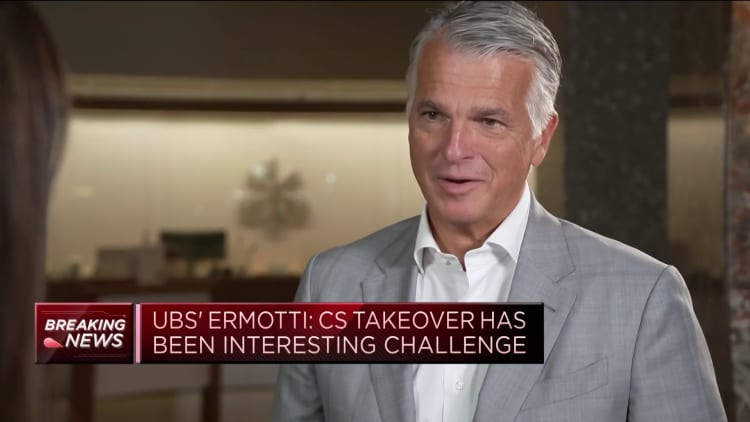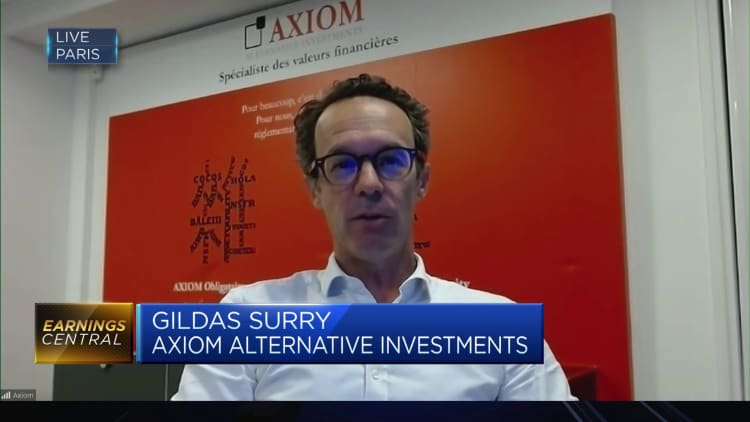UBS shares rallied to 15-year highs on the back of what analysts branded a “historic” earnings report, though Deutsche Bank said the Swiss banking giant may remain a “construction site” for some time.
The group posted a $28.88 billion second-quarter net profit on Thursday as a result of a $28.93 billion in negative goodwill from its acquisition of stricken rival Credit Suisse, which was brokered by Swiss authorities in March and completed on June 12.
UBS also announced that it will fully integrate Credit Suisse’s Swiss banking unit, a key profit center, in 2024. This will result in 1,000 redundancies on top of a further 2,000 reduction in headcount across the group as part of a mass restructure of the rescued lender.
UBS shares were up 5.6% by mid-afternoon in Zurich on Thursday, touching levels not seen since late 2008.
Notably, UBS highlighted that the massive net asset and deposit outflows seen by Credit Suisse over the last year have finally begun to reverse, and turned positive in June. Meanwhile, UBS’ CET1 ratio, a measure of bank solvency, nudged up to 14.4% from 14.2% in the same period last year, despite the disruption of one of the largest mergers in banking history.
“The underlying UBS business is seemingly not impacted by the deal. Non-Core is significant but made solid progress and the CET1 ratio was strong/ahead of expectations in 2Q23,” Deutsche Bank analysts Benjamin Goy and Sharath Kumar said in a research note Thursday.
“Clearly the group remains a construction site in the near term, however we believe this set of results and announcements should give confidence in the mid-term bull case, Buy.”
This bullishness was echoed by Bruno Verstraete, partner at Zurich-based Lakefield Partners, who told CNBC that Thursday’s result was a “once in a blue moon, historic number.”
“Clearly the good news is indeed that stabilization came and that the market seems to de-risk what was out there and what was potentially something which still had some hidden dead bodies in the cupboard,” he said, referring to the Credit Suisse’s troubled history of legacy compliance and oversight failures.
“That seems not to be the case now, that seems to be under control, and I think investors are really reacting positively to that.”

Earlier this month, UBS announced that it had ended a 9 billion Swiss franc ($10.24 billion) loss protection agreement and a 100 billion Swiss franc public liquidity backstop that were put in place by the Swiss government when it agreed to take over Credit Suisse in March.
Verstraete suggested that severing any financial dependence on the Swiss government and central bank had freed up UBS to take the decision on absorbing Credit Suisse’s domestic banking unit without being subject to any political pressure. The prospect of further mass layoffs may be unpopular among some portions of the political and public sphere in Switzerland.
“It’s difficult to combine a blowout result like that and then to announce layoffs at the same time. I think there will be different ways of layoffs in order to get to that integration and into the cost cutting opportunity that is there. That’s clearly positive for the investors,” Verstraete said.
However, he argued that it is in the interests of the Swiss public to have a “solid bank.”
“One third of Switzerland is banking with the group, combined. They want to have a stable group, they don’t want to have a mastodon created that is too big to save. I think this de-risking, this going from a risk culture to another one is something that is clearly going to be beneficial for the general public in the end,” Verstraete added.

UBS on Thursday announced plans to further wind down non-core units of Credit Suisse’s ailing investment bank, wealth management and asset management divisions, which it said are “not aligned with our strategy and policies.”
Gildas Surry, senior analyst at Paris-based Axiom Alternative Investments, told CNBC on Thursday that the market will be closely watching UBS’ efforts to wind down these non-core divisions, and seeking further guidance on the future of the bank’s CET1 ratio.
“What is very positive is the actual inflows, so the deposit reversal is taking place that’s also a very good sign for the franchise,” Surry said.
“The integration of Swiss operations from Credit Suisse is very much in line so nothing new there, but what’s going to be very interesting is indeed the timeline of share buybacks, and for that we need to have the repayment of the funding line from the Swiss National Bank and also the demonstration that UBS has access to the AT1 markets following the writedowns of the Credit Suisse AT1s in March.”
The Swiss government, central bank and UBS came under fire in March after the emergency rescue package included the controversial writedown of 16 billion Swiss francs of Credit Suisse AT1 bonds.
Read the full article here















